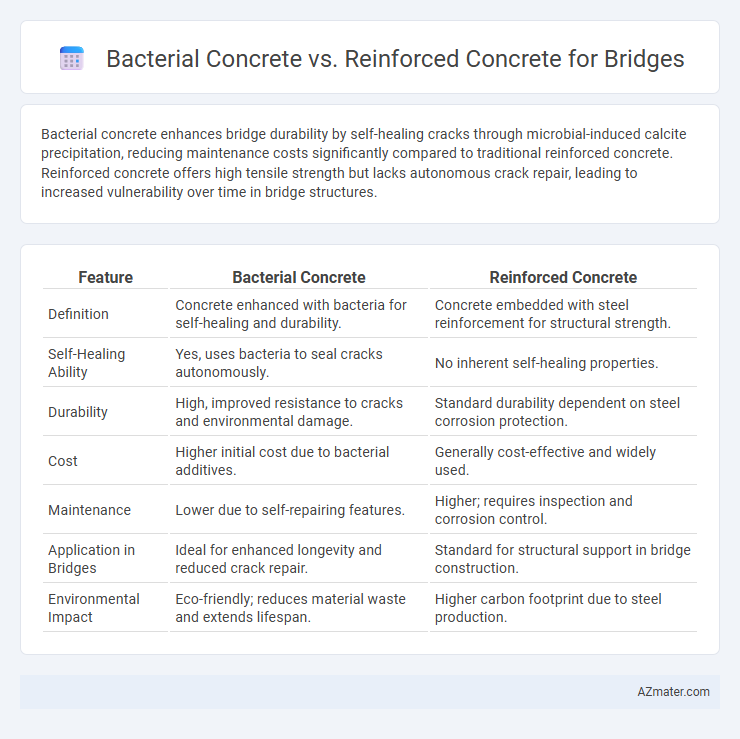Bacterial concrete enhances bridge durability by self-healing cracks through microbial-induced calcite precipitation, reducing maintenance costs significantly compared to traditional reinforced concrete. Reinforced concrete offers high tensile strength but lacks autonomous crack repair, leading to increased vulnerability over time in bridge structures.
Table of Comparison
| Feature | Bacterial Concrete | Reinforced Concrete |
|---|---|---|
| Definition | Concrete enhanced with bacteria for self-healing and durability. | Concrete embedded with steel reinforcement for structural strength. |
| Self-Healing Ability | Yes, uses bacteria to seal cracks autonomously. | No inherent self-healing properties. |
| Durability | High, improved resistance to cracks and environmental damage. | Standard durability dependent on steel corrosion protection. |
| Cost | Higher initial cost due to bacterial additives. | Generally cost-effective and widely used. |
| Maintenance | Lower due to self-repairing features. | Higher; requires inspection and corrosion control. |
| Application in Bridges | Ideal for enhanced longevity and reduced crack repair. | Standard for structural support in bridge construction. |
| Environmental Impact | Eco-friendly; reduces material waste and extends lifespan. | Higher carbon footprint due to steel production. |
Introduction to Bridge Construction Materials
Bacterial concrete incorporates microorganisms that stimulate calcium carbonate precipitation, enhancing self-healing properties and durability in bridge construction. Reinforced concrete, composed of concrete and steel rebar, provides high compressive and tensile strength essential for load-bearing bridge structures. Innovations in bacterial concrete aim to reduce maintenance costs and extend the lifespan compared to traditional reinforced concrete in bridge engineering.
Overview of Reinforced Concrete
Reinforced concrete, a composite material of concrete embedded with steel reinforcement bars, exhibits high tensile strength and durability, making it a prevalent choice in bridge construction. This combination optimizes load-bearing capacity, enabling bridges to withstand heavy traffic and environmental stresses over extended periods. Its proven performance and cost-effectiveness contribute to reinforced concrete's widespread application in modern infrastructure projects.
Understanding Bacterial Concrete Technology
Bacterial concrete incorporates self-healing bacteria that precipitate calcium carbonate, enhancing crack repair and durability, making it a sustainable option for bridge construction. Reinforced concrete relies on steel bars for strength and load-bearing capacity but is prone to corrosion and requires maintenance. Understanding bacterial concrete technology involves studying microbial-induced calcite precipitation, which improves structural longevity and reduces maintenance costs in bridge engineering.
Durability Comparison: Bacterial vs Reinforced Concrete
Bacterial concrete enhances bridge durability by self-healing microcracks through calcite precipitation, significantly reducing permeability and increasing resistance to environmental degradation compared to traditional reinforced concrete. Reinforced concrete, while strong under compressive and tensile loads due to embedded steel reinforcement, is susceptible to corrosion and crack propagation that compromise structural integrity over time. The self-healing properties of bacterial concrete extend the lifespan of bridge structures by minimizing maintenance needs and preventing the ingress of harmful agents that typically deteriorate reinforced concrete.
Crack Healing Abilities in Bacterial Concrete
Bacterial concrete exhibits superior crack healing abilities compared to reinforced concrete, as specialized bacteria within the mix produce calcite that fills microcracks, enhancing durability and structural integrity. This self-healing mechanism reduces maintenance costs and extends the lifespan of bridge structures by preventing water ingress and corrosion of reinforcement. Reinforced concrete lacks this intrinsic repair feature, making bacterial concrete a promising innovation for sustainable bridge construction.
Structural Performance and Load-Bearing Capacity
Bacterial concrete enhances the structural performance of bridges by promoting self-healing properties that reduce micro-cracks and increase durability under cyclic loading, thereby extending the lifespan of the structure compared to traditional reinforced concrete. Reinforced concrete relies on steel reinforcement to provide high load-bearing capacity, effectively resisting tensile stresses and supporting heavy loads but may suffer from corrosion and cracking over time. In bridge applications, bacterial concrete offers improved crack resistance and maintenance reduction, while reinforced concrete remains superior in immediate load-bearing strength and well-established design reliability.
Environmental Impact and Sustainability
Bacterial concrete significantly reduces carbon emissions by promoting self-healing properties that extend bridge lifespan and decrease the need for frequent repairs, unlike reinforced concrete which often requires energy-intensive maintenance. The use of bacteria in concrete production lowers cement consumption, a major contributor to CO2 emissions, enhancing overall sustainability in bridge construction projects. Reinforced concrete, while durable, generally has a larger environmental footprint due to higher raw material extraction and less efficient waste reduction compared to bacterial concrete technologies.
Cost Analysis: Initial and Long-Term Investment
Bacterial concrete reduces long-term maintenance costs in bridge construction by promoting self-healing of cracks, significantly extending structural lifespan compared to reinforced concrete. The initial investment for bacterial concrete is higher due to the cost of incorporating microbial agents, but this is offset by decreased repair frequency and enhanced durability over time. Reinforced concrete has a lower upfront cost but incurs greater expenses from frequent maintenance and potential early deterioration of bridge components.
Maintenance and Longevity Factors
Bacterial concrete incorporates self-healing bacteria that precipitate calcium carbonate, significantly reducing crack propagation and enhancing durability, thereby lowering maintenance frequency compared to traditional reinforced concrete. Reinforced concrete, while strong under load, is prone to corrosion of steel reinforcements due to moisture ingress, leading to costly repairs and shorter service life. The self-healing properties of bacterial concrete extend bridge longevity by mitigating micro-cracks and preventing structural degradation over time, offering superior performance in maintenance and lifespan metrics.
Future Prospects and Innovations in Bridge Engineering
Bacterial concrete enhances durability and self-healing capabilities, reducing maintenance costs and extending bridge lifespan compared to traditional reinforced concrete. Innovations in microbial-induced calcite precipitation (MICP) offer eco-friendly solutions to cracks and structural damages, promoting sustainability in bridge engineering. Ongoing research focuses on integrating nanotechnology and smart sensors with bacterial concrete to monitor structural health and optimize performance in future bridge designs.

Infographic: Bacterial concrete vs Reinforced concrete for Bridge
 azmater.com
azmater.com